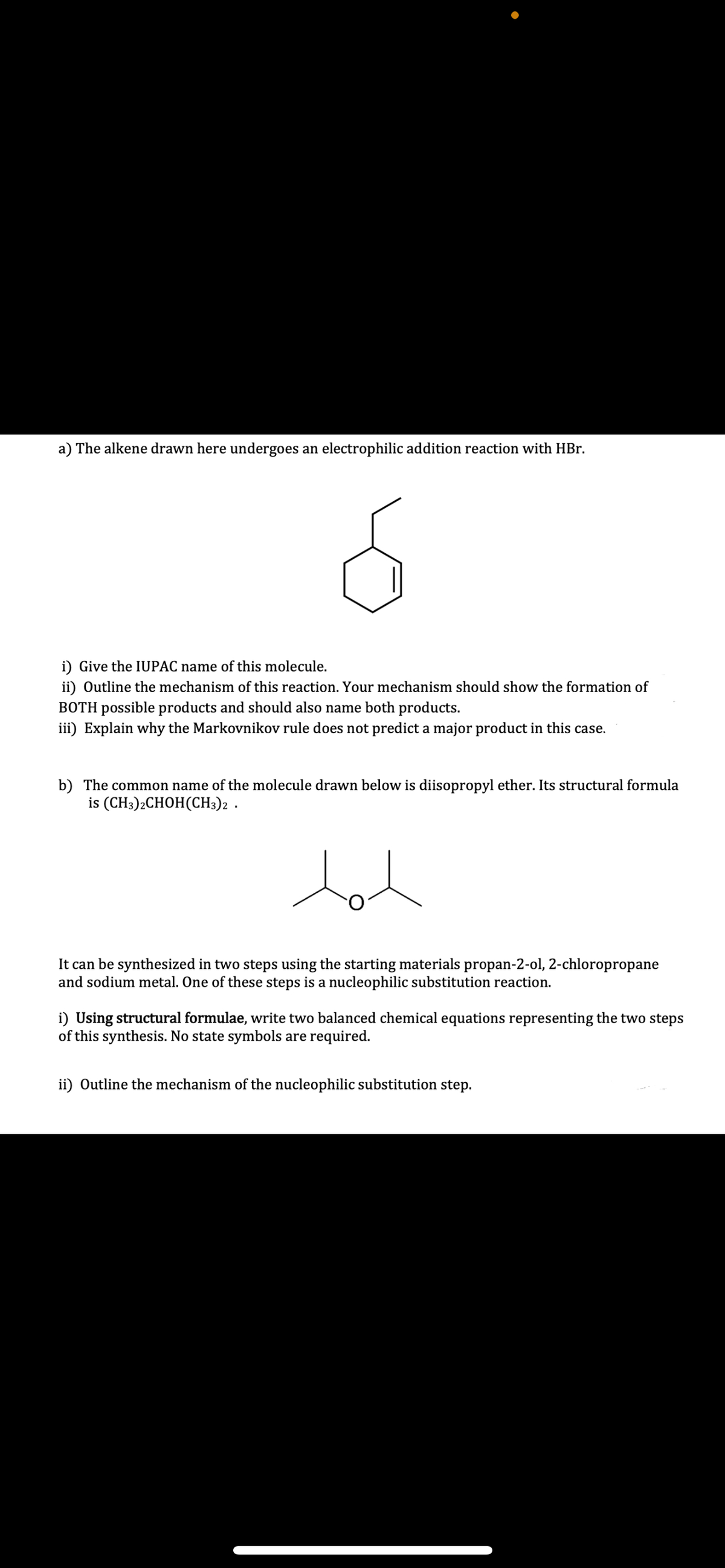Organic Chemistry
8th Edition
ISBN:9781305580350
Author:William H. Brown, Brent L. Iverson, Eric Anslyn, Christopher S. Foote
Publisher:William H. Brown, Brent L. Iverson, Eric Anslyn, Christopher S. Foote
Chapter8: Haloalkanes, Halogenation, And Radical Reactions
Section: Chapter Questions
Problem 8.21P
Related questions
Question
A)I,ii and iii please

Transcribed Image Text:a) The alkene drawn here undergoes an electrophilic addition reaction with HBr.
5
i) Give the IUPAC name of this molecule.
ii) Outline the mechanism of this reaction. Your mechanism should show the formation of
BOTH possible products and should also name both products.
iii) Explain why the Markovnikov rule does not predict a major product in this case.
b) The common name of the molecule drawn below is diisopropyl ether. Its structural formula
is (CH3)2CHOH(CH3)2.
tot
It can be synthesized in two steps using the starting materials propan-2-ol, 2-chloropropane
and sodium metal. One of these steps is a nucleophilic substitution reaction.
i) Using structural formulae, write two balanced chemical equations representing the two steps
of this synthesis. No state symbols are required.
ii) Outline the mechanism of the nucleophilic substitution step.
Expert Solution
This question has been solved!
Explore an expertly crafted, step-by-step solution for a thorough understanding of key concepts.
Step by step
Solved in 3 steps with 2 images

Knowledge Booster
Learn more about
Need a deep-dive on the concept behind this application? Look no further. Learn more about this topic, chemistry and related others by exploring similar questions and additional content below.Recommended textbooks for you

Organic Chemistry
Chemistry
ISBN:
9781305580350
Author:
William H. Brown, Brent L. Iverson, Eric Anslyn, Christopher S. Foote
Publisher:
Cengage Learning

Organic Chemistry: A Guided Inquiry
Chemistry
ISBN:
9780618974122
Author:
Andrei Straumanis
Publisher:
Cengage Learning

Chemistry for Today: General, Organic, and Bioche…
Chemistry
ISBN:
9781305960060
Author:
Spencer L. Seager, Michael R. Slabaugh, Maren S. Hansen
Publisher:
Cengage Learning

Organic Chemistry
Chemistry
ISBN:
9781305580350
Author:
William H. Brown, Brent L. Iverson, Eric Anslyn, Christopher S. Foote
Publisher:
Cengage Learning

Organic Chemistry: A Guided Inquiry
Chemistry
ISBN:
9780618974122
Author:
Andrei Straumanis
Publisher:
Cengage Learning

Chemistry for Today: General, Organic, and Bioche…
Chemistry
ISBN:
9781305960060
Author:
Spencer L. Seager, Michael R. Slabaugh, Maren S. Hansen
Publisher:
Cengage Learning